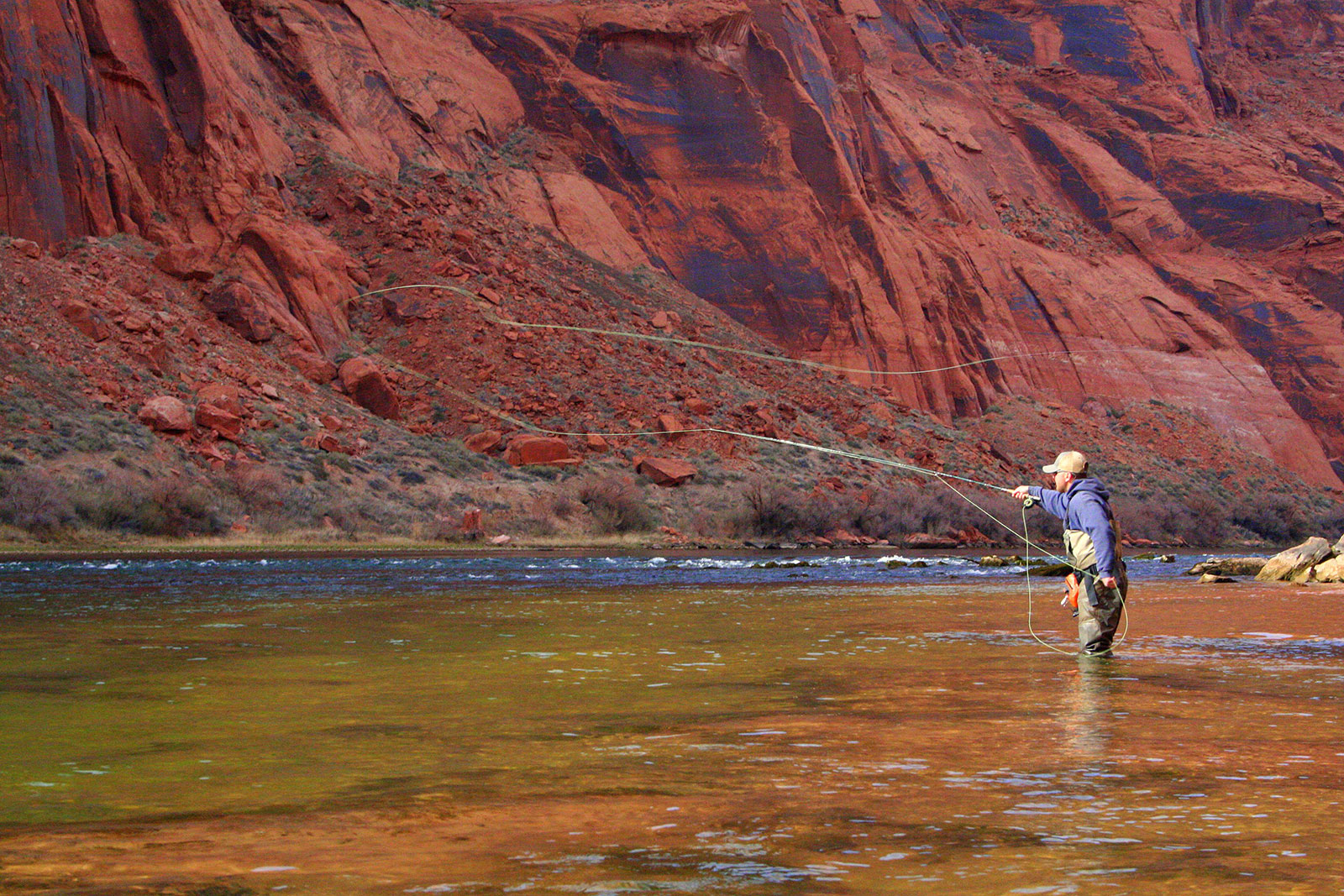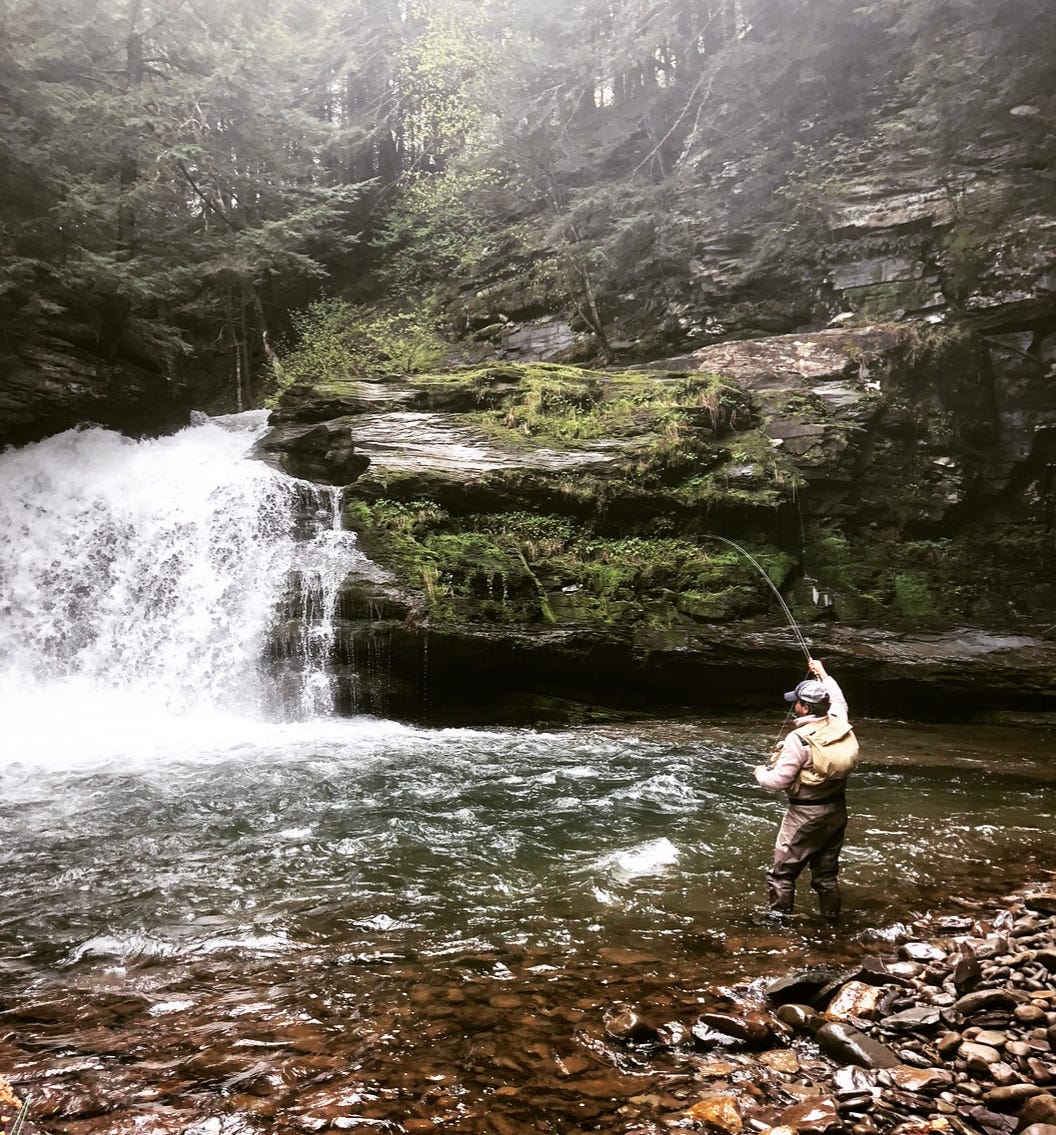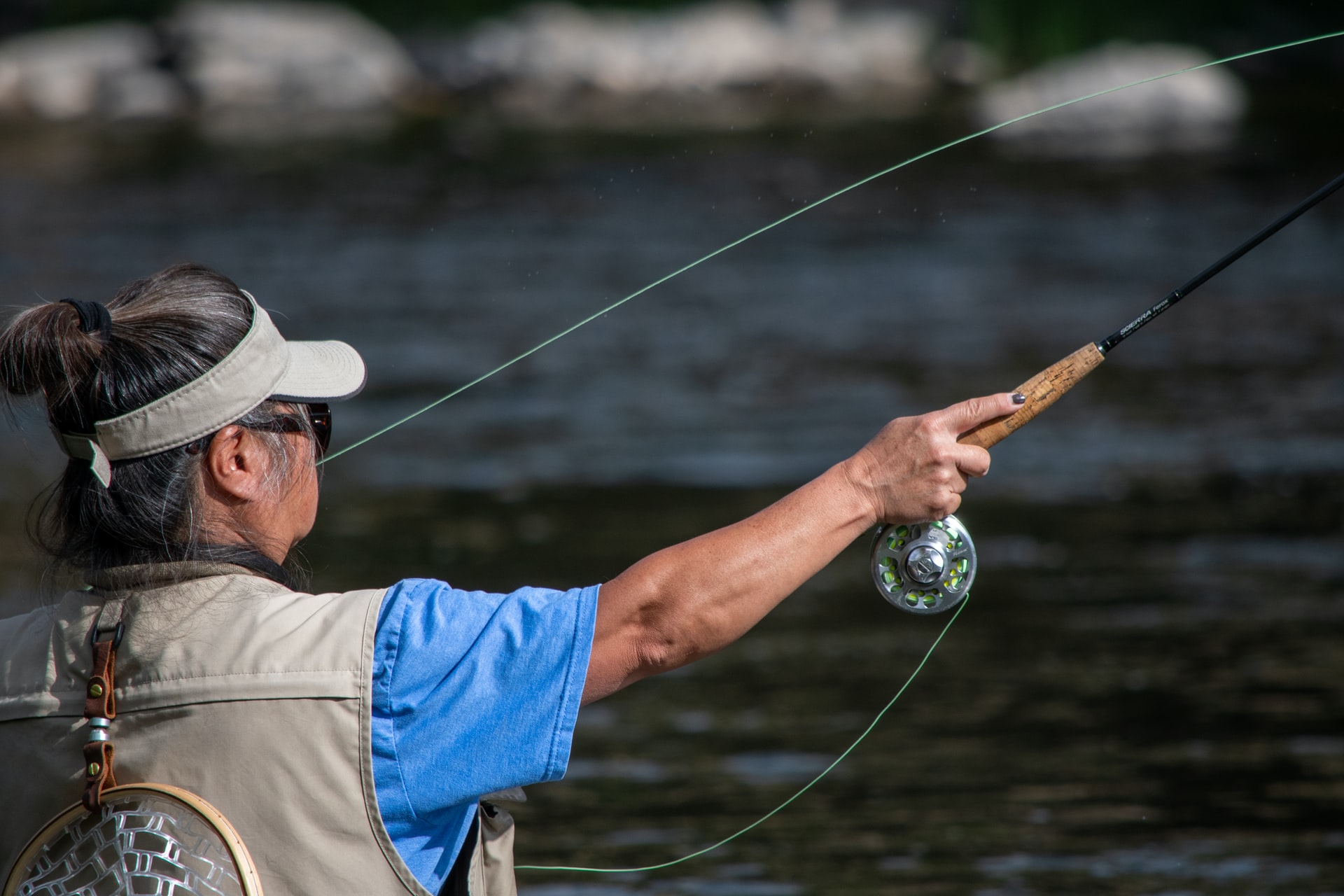Fly fishing is a unique and fulfilling way to connect with nature, offering a blend of technical skill and serene relaxation. This sport, known for its delicate casting techniques and specialized gear, can seem overwhelming to beginners. Consequently, knowing where to begin helps you navigate this fascinating hobby confidently. Therefore, this comprehensive guide outlines the basics of fly fishing, including essential gear, basic casting techniques, and tips for beginners. By understanding these elements, you can embark on your fly fishing journey with enthusiasm and skill, maximizing your enjoyment along the way.
Gathering Essential Gear for Fly Fishing
The first step to starting fly fishing is equipping yourself with the necessary gear. Understanding the importance of each item ensures a smooth and effective experience. Therefore, exploring the essential gear for fly fishing is crucial.

Fly Rod and Reel
The fly rod and reel are the cornerstone pieces of your fly fishing setup. Rods come in various lengths and weights, each suited to different conditions and species. A good starting point for beginners is a 9-foot, 5-weight rod, which offers versatility for various waters and fish types. The reel should balance well with the rod, providing smooth drag and ample line capacity. By understanding how to choose a fly rod and reel, you can ensure your setup performs effectively. Therefore, recognizing the importance of these components is crucial.
Fly Line, Leader, and Tippet
Fly line is another essential component, specifically designed for casting lightweight flies. It comes in different weights and tapers; a weight-forward floating line is ideal for beginners. Attach a leader to the end of the fly line, which tapers down to a thinner section for delicate presentations. The tippet is an additional length of line tied to the leader’s end, allowing for easy fly changes. By understanding the role of fly line, leader, and tippet, you can achieve more accurate and delicate casts. Therefore, recognizing the significance of these lines is essential.
Flies and Fly Box
Flies are the artificial lures used in fly fishing, imitating insects or baitfish to attract fish. They come in various patterns, including dry flies, nymphs, and streamers. Beginners should start with a basic selection of flies that match the local insect life. A fly box helps organize and protect your flies, keeping them readily accessible. By understanding different types of flies and their uses, you can select the right ones for your fishing conditions. Therefore, recognizing the importance of a well-stocked fly box is crucial.
Learning Basic Casting Techniques
Mastering basic casting techniques is fundamental to fly fishing success. Understanding these techniques helps you place your fly accurately and naturally. Therefore, exploring basic casting techniques is essential.

The Overhead Cast
The overhead cast is the most common and fundamental fly fishing cast. Begin with the rod tip low, holding the line with your free hand. Accelerate the rod upwards and backwards until it reaches the 1 o’clock position, then pause briefly to let the line straighten. Next, bring the rod forward in a smooth motion, stopping at the 10 o’clock position, allowing the line to unfurl and the fly to land gently on the water. Practicing the overhead cast builds muscle memory and control. By understanding how to perform the overhead cast, you can achieve more precise and effective presentations. Therefore, recognizing the importance of basic casts is crucial.
The Roll Cast
The roll cast is useful when limited space behind you prevents a full backcast. Start with the rod tip low, lifting it smoothly to create a loop with the line behind you. Pause briefly, then push the rod forward with a flicking motion, causing the loop to roll out and straighten on the water. The roll cast is ideal for casting in tight spaces or dealing with windy conditions. By understanding how to execute the roll cast, you can adapt to various fishing situations. Therefore, recognizing the value of alternative casting techniques is essential.
Understanding Fly Fishing Basics
Beyond gear and casting, understanding the basics of fly fishing techniques and behavior is essential. These fundamentals help you adapt to different fishing scenarios. Therefore, delving into the basics of fly fishing techniques is crucial.
Reading the Water
Reading the water involves identifying where fish are likely to be located. Look for areas with structure, such as rocks, logs, and vegetation, which provide shelter and food sources. Pay attention to current seams where fast and slow water meet, as fish often hold in these areas to conserve energy while feeding. Observing insect activity and surface disturbances can also indicate fish presence. By understanding how to read the water, you can place your fly more strategically. Therefore, recognizing the importance of water reading is crucial.

Matching the Hatch
Matching the hatch refers to imitating the specific insects fish are currently feeding on. Research the local insect life and carry flies that represent different stages of their life cycle, including nymphs, emergers, and adults. Observe the water and surroundings to determine which insects are active. Using flies that closely resemble the natural food sources increases your chances of enticing a strike. By understanding how to match the hatch, you can make more informed fly selections. Therefore, recognizing the significance of this technique is essential.
Practical Tips for Beginner Fly Fishers
Starting your fly fishing journey involves practical tips to enhance your experience and success. Understanding these tips helps you navigate challenges and refine your skills. Therefore, exploring practical tips for beginners is essential.
Start with Simpler Waters
Beginning with simpler waters, such as small streams and ponds, helps build confidence and skills. These waters are often easier to read and require shorter casts, making them ideal for practicing basic techniques. Focus on developing your casting accuracy, line control, and fly presentation in these settings before progressing to more challenging waters. By understanding the benefits of starting in simpler waters, you can build a solid foundation for more complex fishing scenarios. Therefore, recognizing the value of a gradual learning curve is crucial.
Practice Regularly
Regular practice is key to improving your fly fishing skills. Set aside time to practice casting, even if it’s in your backyard or a nearby park. Repetition builds muscle memory and refines your technique, leading to more accurate and effective presentations. Additionally, practicing on the water helps you learn to adapt to different conditions and fish behavior. By understanding the importance of regular practice, you can enhance your proficiency and confidence. Therefore, recognizing the value of consistent practice is essential.
Join a Fly Fishing Community
Joining a fly fishing community offers support, knowledge, and camaraderie. Local fly fishing clubs, online forums, and social media groups provide valuable resources, such as beginner tips, gear recommendations, and fishing reports. Engaging with experienced anglers allows you to learn from their insights and share your experiences. Community events, such as workshops and group outings, offer hands-on learning opportunities. By understanding the benefits of joining a fly fishing community, you can accelerate your learning and enjoyment. Therefore, recognizing the importance of community engagement is crucial.

Addressing Common Questions About Fly Fishing
Understanding common questions about fly fishing provides additional clarity and guidance for beginners. Knowledge of these answers ensures better preparation and confidence. Therefore, exploring common questions is essential.
How Much Should I Invest in Gear?
A common question for beginners is how much to invest in fly fishing gear. While high-end gear offers superior performance and durability, beginners can start with reasonably priced equipment. Focus on essential items such as a reliable rod and reel, fly line, leader, tippet, and a selection of basic flies. Beginners can find quality gear at various price points, allowing them to enjoy the sport without a significant initial investment. By understanding how to budget for fly fishing gear, you can make informed purchasing decisions. Therefore, recognizing the importance of balanced investment is crucial.
What Species Can I Target with Fly Fishing?
Another common question is what species can be targeted with fly fishing. Fly fishing is versatile, allowing anglers to target various species, including trout, bass, panfish, and even saltwater species like bonefish and tarpon. The techniques and gear may vary based on the target species and fishing environment. Beginners should start with readily available species in local waters to build confidence and experience. By understanding the range of species available for fly fishing, you can choose suitable targets for your skill level. Therefore, recognizing the versatility of fly fishing is essential.
Addressing Common Misconceptions About Fly Fishing
Addressing common misconceptions about fly fishing provides accurate information and dispels unwarranted concerns. Clearing up misunderstandings ensures an informed perspective. Therefore, exploring common misconceptions is important.
Misconception: Fly Fishing Is Only for Trout
A common misconception is that fly fishing is only suitable for trout. While trout are a popular target, fly fishing is effective for various species in both freshwater and saltwater environments. Techniques and gear can be adapted to target species such as bass, panfish, pike, redfish, and bonefish. By understanding the versatility of fly fishing, anglers can explore diverse fishing opportunities beyond trout. Therefore, dispelling this misconception highlights the broader scope of fly fishing.
Misconception: Fly Fishing Is Too Difficult for Beginners
Another misconception is that fly fishing is too difficult for beginners. While fly fishing involves unique techniques and gear, beginners can learn the basics with patience and practice. Instructional resources, such as books, videos, and classes, provide valuable guidance. Starting with simpler waters and gradually progressing builds confidence and skills. By understanding the accessibility of fly fishing for beginners, newcomers can approach the sport with confidence. Therefore, dispelling this misconception emphasizes the attainability of fly fishing.

Conclusion: Embarking on Your Fly Fishing Journey
Embarking on your fly fishing journey involves understanding essential gear, basic casting techniques, and practical tips. Proper knowledge of these aspects ensures a comprehensive and enjoyable experience.
Exploring critical elements such as rod and reel selection, casting methods, reading water, and matching the hatch provides a solid foundation for beginners. Recognizing the importance of regular practice, joining a community, and addressing common questions enhances overall proficiency and confidence.
By engaging with these elements, you can start your fly fishing journey with enthusiasm, skill, and a deeper connection to nature. Therefore, whether you are a newcomer or a seasoned angler looking to expand your skills, understanding how to start fly fishing offers practical and valuable insights. Embrace the opportunity to learn and grow, knowing you have the knowledge and resources to enjoy the art of fly fishing!
